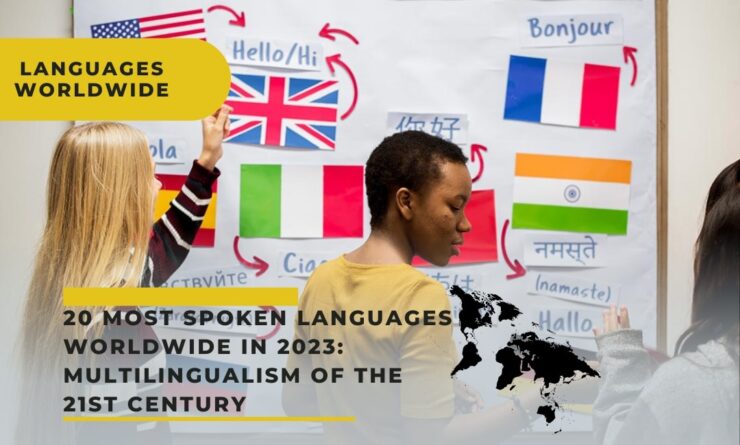Did you know that over 7,000 languages are spoken worldwide today? In this article, we will discuss the top 20 most spoken languages globally as of January 2024.
Let’s start!
| S.No | Language | Total Speakers |
|---|---|---|
| 1 | English | 1.45 B |
| 2 | Mandarin | 1.12 B |
| 3 | Hindi | 602 M |
| 4 | Spanish | 548 M |
| 5 | French | 274 M |
| 6 | Arabic | 274 M |
| 7 | Bengali | 273 M |
| 8 | Russian | 258 M |
| 9 | Portuguese | 257 M |
| 10 | Urdu | 231 M |
| 11 | Indonesian | 199 M |
| 12 | German | 135 M |
| 13 | Japanese | 125 M |
| 14 | Nigerian | 121 M |
| 15 | Marathi | 99.1 M |
| 16 | Telugu | 95.7 M |
| 17 | Turkish | 88.1 M |
| 18 | Tamil | 86.4 M |
| 19 | Yue Chinese | 85.6 M |
| 20 | Vietnamese | 85.3 M |
English | 1.45 Billion
Unsurprisingly, English is the world’s most spoken language, with approximately 1.5 billion speakers. It serves as the official language for numerous countries and has become the most widely used language for travel, business, and international communication.
English is considered the international language of business and is widely used in the global economy. Many international companies and organizations use English as their primary language for communication and negotiation. Moreover, it is the primary language of the internet and has become an essential tool for communication and information exchange.
It has also become the primary language of travel, with many tourist destinations offering English-language services to cater to their visitors. Additionally, English is a popular choice for students as a second language, with many universities offering English language courses to international students.
Mandarin Chinese | 1.12 Billion
With about 1.1 billion speakers, Mandarin Chinese is the second most spoken language globally. It is the official language in China, Taiwan, and Singapore, among other places, and plays a critical role in international business and politics.
Mandarin Chinese is a tonal language, meaning that the meaning of a word changes depending on the tone in which it is spoken. It is considered one of the more challenging languages to learn for non-native speakers due to its complex grammar and writing system.
As China’s economy continues to grow, Mandarin Chinese is becoming increasingly important in international business and trade. Many multinational corporations have offices or manufacturing facilities in China, and the ability to speak Mandarin Chinese can be a significant advantage in conducting business in the region.
Hindi | 602 Million
Hindi is India’s most spoken language, with over 600 million speakers. As India’s and Fiji’s official language, Hindi has a rich history dating back centuries, with influences from Sanskrit and other regional languages.
Hindi is a descendant of Sanskrit, and it has also been influenced by other regional languages, such as Punjabi, Bengali, and Marathi. Hindi is written in the Devanagari script, which has 47 letters and is used to write several other languages spoken in India.
Apart from being spoken in India and Fiji, Hindi is also spoken by Indian expatriates all over the world. It has also gained popularity as a language for Bollywood movies, which have a significant following in many countries.
Spanish | 548 Million
Spanish is spoken by nearly 550 million people and is the official language of 21 countries. It has become essential for international business, diplomacy, and tourism and serves as one of the United Nations’ six official languages.
The influence of the Spanish language is felt across the world, especially in business, diplomacy, and tourism. Spanish is the third most used language on the internet, and it is essential in international trade and commerce. Many multinational corporations have offices or manufacturing facilities in Spanish-speaking countries, making the ability to speak Spanish a significant advantage for business professionals.
Additionally, Spanish has become an essential language in international diplomacy, with Spanish being one of the six official languages of the United Nations. It is also widely used in other international organizations, such as the World Trade Organization and the Organization of American States.
French | 274 Million
French is spoken by more than 270 million people worldwide, making it one of Europe’s most spoken languages. It has a long history as a language of diplomacy, literature, and science and is an official language in 29 countries.
Moreover, French is a significant language in the fields of science and academia. Many scientific and academic papers are written in French, and French universities are recognized worldwide for their quality of education and research.
In addition to its cultural significance, French is also widely used in international business and commerce. France has one of the world’s largest economies, and many multinational corporations have offices or manufacturing facilities in French-speaking countries. The ability to speak French can provide a competitive edge in the global job market.
Arabic | 274 Million
Arabic has a rich cultural heritage that spans over 2,500 years. As one of the United Nations’ six official languages, it has been used by scholars and academics throughout history.
Arabic has been a language of scholarship and academics throughout history. It is the language of the Quran, the holy book of Islam, and has been used by scholars and intellectuals in fields such as philosophy, literature, and mathematics.
In addition to its historical significance, Arabic is also an essential language for international diplomacy and business. The Middle East is home to some of the world’s largest oil reserves, and Arabic-speaking countries play a vital role in global politics and economics. The ability to speak Arabic can be a significant advantage for professionals working in international business and diplomacy.
Bengali | 272 Million
Bengali is the official language of Bangladesh and India and is spoken by millions of people in other countries. It has a rich literary tradition, with famous works like Tagore’s Gitanjali and Rabindranath Tagore’s Chokher Bali.
Apart from its literary significance, Bengali is also important in business and commerce. Bangladesh is a rapidly growing economy, and many multinational corporations have offices or manufacturing facilities in the country. The ability to speak Bengali can provide a significant advantage for professionals working in the region.
Moreover, Bengali is a language with a unique writing system, known as the Bengali script, which is used to write not only Bengali but also several other languages spoken in the region, such as Assamese and Manipuri.
Russian | 258 Million
Russian, with 258 million speakers, is the official language of Russia and is also spoken in other countries such as Belarus and Ukraine. It is a blend of Greek and Slavic languages, and its Cyrillic alphabet is considered easy to learn.
Apart from its cultural significance, Russian is also essential in international business and politics. Russia is a vast country with significant natural resources, and many multinational corporations have offices or manufacturing facilities in the country. The ability to speak Russian can provide a significant advantage in conducting business in the region.
Moreover, Russian is also an important language in international diplomacy, as Russia plays a crucial role in global politics. The language is used in international organizations such as the United Nations and the International Olympic Committee.
Portuguese | 257 Million
Portuguese is an official language in nine countries, including Brazil and Portugal. It has been influenced by many languages throughout history, with around 30% of its words derived from Latin or other Romance languages.
Apart from its linguistic significance, Portuguese is also essential in business and commerce. Brazil is one of the world’s largest economies, and many multinational corporations have offices or manufacturing facilities in the country. The ability to speak Portuguese can provide a significant advantage for professionals working in the region.
Moreover, Portuguese is a language with a rich cultural heritage. Portuguese literature, music, and art have made significant contributions to world culture, with renowned authors such as Fernando Pessoa and Jose Saramago, and musicians like Bossa Nova pioneer Joao Gilberto.
Urdu | 231 Million
Urdu, primarily derived from Persian and Arabic, has 230 million speakers as of 2024. Its unique abjad writing system, which does not use vowels, makes it distinctive. Urdu poetry and literature have been popular since medieval times.
Urdu’s unique abjad writing system, which does not use vowels, makes it distinctive and challenging to learn for speakers of other languages. However, Urdu poetry and literature have been popular since medieval times, and the language has made significant contributions to the arts and culture of the Indian subcontinent.
Indonesian | 199 Million
Indonesian belongs to the Austronesian language family and is closely related to languages like Malay and Javanese. It dates back to the 16th century when it was common in trading ports across Southeast Asia.
ndonesian has a relatively straightforward grammar and a simplified writing system, making it relatively easy for learners to pick up. It dates back to the 16th century when it was common in trading ports across Southeast Asia and has evolved over time, with influences from Dutch, Arabic, and other languages.
German | 135 Million
German is spoken by a large population in Germany, Austria, and Switzerland. Its four cases and words from other languages, such as English and French, can make it challenging to learn for English speakers.
Japanese | 125 Million
Japanese, with its unique writing system and complex grammar, is a fascinating language with a rich history and culture dating back to 3 A.D. Several dialects of the language are spoken throughout Japan, varying greatly by region and even within households.
Several dialects of the language are spoken throughout Japan, varying greatly by region and even within households. The language’s complex grammar and honorific system can make it challenging for non-native speakers to learn, but it is also an incredibly rewarding language to master.
Nigerian | 121 Million
Nigerian languages are spoken by Nigeria’s citizens and are divided into three major language families: Afro-Asiatic, Niger-Congo, and Nilo-Saharan. Although English, inherited from British colonization, is Nigeria’s official language, many Nigerians also speak their native languages, such as Yoruba or Igbo.
Although English, inherited from British colonization, is Nigeria’s official language, many Nigerians also speak their native languages, such as Yoruba, Igbo, or Hausa. These languages have rich cultural heritages and play an essential role in preserving Nigeria’s diverse cultural identities.
Moreover, the ability to speak these native languages can be an advantage in business and commerce. Nigeria is the largest economy in Africa, and many multinational corporations have offices or manufacturing facilities in the country. The ability to speak local languages can provide a significant advantage for professionals working in the region.
Marathi | 99.1 Million
Marathi, one of the world’s oldest languages, is an Indo-Aryan language spoken mainly in the Indian state of Maharashtra. It has a unique writing system called Modi script, which is still used today by some traditional communities in Maharashtra for religious texts and other manuscripts.
Telugu | 95.7 Million
Telugu is the official language of the South Indian state of Andhra Pradesh and is one of the 22 scheduled languages recognized by the Indian government.
Moreover, Telugu is an essential language in the fields of business and commerce. Andhra Pradesh is a rapidly growing economy, and many multinational corporations have offices or manufacturing facilities in the state. The ability to speak Telugu can provide a significant advantage for professionals working in the region.
Furthermore, learning Telugu can be an enriching experience, providing access to a vibrant and diverse culture. Telugu cuisine, for example, is known for its spicy and flavorful dishes, such as biryani and dosa.
Turkish | 88.1 Million
Turkish has roots in languages such as Arabic, Persian, and French. Its complex grammar system reflects this rich blend of languages. The unique Ottoman Turkish Script was used until 1928 when it was replaced by Latin script.
Moreover, Turkish is an essential language in business and commerce. Turkey is a rapidly growing economy, and many multinational corporations have offices or manufacturing facilities in the country. The ability to speak Turkish can provide a significant advantage for professionals working in the region.
Furthermore, learning Turkish can be an enriching experience, providing access to a fascinating and diverse culture. Turkish cuisine, for example, is renowned for its delicious and flavorful dishes, such as kebabs, meze, and baklava.
Tamil | 86.4 Million
Tamil is one of the oldest living languages in the world, dating back to 500 BC. It is not only spoken in India but also in Singapore, Malaysia, Sri Lanka, and Mauritius.
Furthermore, learning Tamil can be an enriching experience, providing access to a vibrant and diverse culture. Tamil cuisine, for example, is known for its delicious and spicy dishes such as dosa, idli, and sambar.
Yue Chinese | 85.6 Million
Yue Chinese has evolved over the centuries, incorporating words from Cantonese, Hakka, Min Nan, and English. It also contains words from other Chinese dialects like Mandarin and Wu, making it a versatile language.
Moreover, Yue Chinese is essential in business and commerce, particularly in Southern China and Hong Kong, which are major economic centers in Asia. The ability to speak Yue Chinese can provide a significant advantage for professionals working in the region.
Furthermore, learning Yue Chinese can be an enriching experience, providing access to a vibrant and diverse culture. Cantonese cuisine, for example, is renowned worldwide for its delicious and unique flavors, with dishes such as dim sum and roasted meats.
Vietnamese | 85.3 Million
Vietnamese, the official language of Vietnam, is spoken by over 76 million people. As a tonal language, words can have different meanings depending on pronunciation. Its complex writing system, comprising more than 3,000 characters, makes it one of the most intriguing languages to study.
FAQ
Which is the most spoken language in the world?
English is the most spoken language in the world with approximately 1.45 billion speakers.
Which is the most spoken language in India?
Hindi is the most spoken language in India, with over 600 million speakers.
What are the most spoken languages in Africa?
There are over 2,000 languages spoken in Africa, but some of the most spoken include Swahili, Hausa, Yoruba, Amharic, Igbo, and Zulu.
What are some of the major dialects of Mandarin Chinese?
Some of the major dialects of Mandarin Chinese include Standard Mandarin, Northern Mandarin, Southern Mandarin, and Southwest Mandarin. Each of these dialects has its unique features and variations in pronunciation, vocabulary, and grammar.
How has the French language influenced the world of literature and art?
French has been a significant language of literature, art, and intellectual discourse for centuries. Many famous literary works, such as Victor Hugo’s “Les Miserables,” were written in French. The language has also influenced art movements like Impressionism, and many famous artists like Claude Monet and Edgar Degas were French speakers.
What are the key differences between British English and American English?
Some key differences between British English and American English include differences in spelling, pronunciation, and vocabulary. For example, British English tends to use more “u”s in words like “colour” and “favour,” while American English often omits them. Additionally, there are differences in vocabulary, with some words like “lorry” being more commonly used in British English and “truck” being used in American English.
What is the significance of Arabic in Islamic culture and history?
Arabic is considered the language of the Quran, the holy book of Islam. As such, it is considered a sacred language by many Muslims and is used in prayer and religious ceremonies. Arabic has also played a significant role in Islamic history and culture, with many important literary, scientific, and philosophical works written in the language.
What are the challenges of learning a language that uses a non-Latin script, such as Hindi or Arabic?
Learning a language that uses a non-Latin script can present several challenges for learners, including mastering a new writing system, learning to recognize and produce new sounds, and developing familiarity with new grammatical structures. Additionally, there may be cultural differences that affect how the language is spoken and used, which can make learning the language even more challenging.
Final Words
These languages, spoken by millions across the globe, each have their unique culture and history. From English to Spanish, Chinese to Hindi, they have persisted for centuries and continue to be used in everyday life, making them the most spoken languages in the world.













